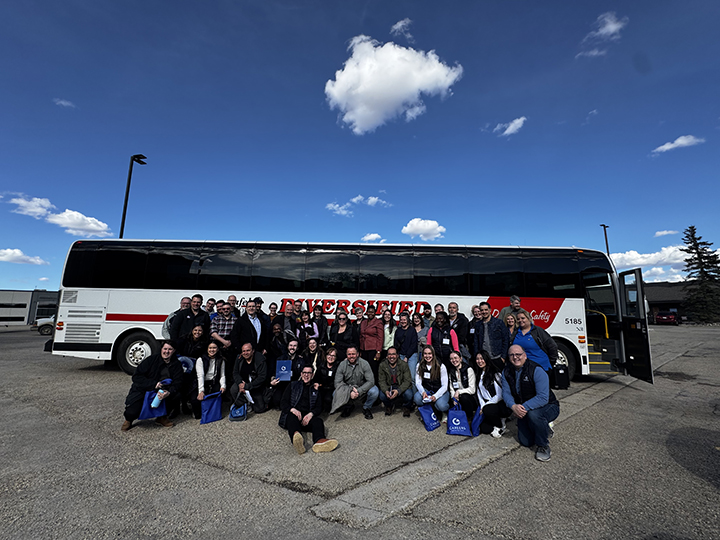On April 9, 2025, a chartered bus travelled through the industrial heart of Alberta’s capital region, carrying 55 educators on a mission to uncover the lesser-known corners of the construction industry.
The Tour of the Trades, a first-of-its-kind collaboration between CAREERS: The Next Generation and the Edmonton Construction Association (ECA), aimed to bridge a critical gap in awareness about high-demand skilled trades. From fire suppression to glazing and commercial roofing, the tour showcased careers that rarely make it onto the radar of students or their teachers, but are vital to Alberta’s economy.
The event was born out of a pressing need. Alberta’s construction sector faces looming workforce shortages, particularly in specialized trades.
“When kids think about trades, they often picture construction or welding,” says Stacey Rishaug, director of communications and marketing at CAREERS. “But there are huge gaps in fields they’ve never even heard of.”
These gaps are already straining employers, with projections indicating even greater demand in the coming years.
The tour’s itinerary was carefully curated to spotlight these overlooked trades. Educators, including off-campus coordinators and career counsellors, visited five sites: Acron Roofing, Alberta Glass, Vipond Inc. (a leader in sprinkler installation), Flynn Roofing and Madsen’s Millwork & Custom Cabinets. At each stop, company leaders and workers offered a glimpse into the daily realities of their trades, emphasizing not just the skills required, but also the financial rewards and long-term career paths available.
“I think they found it quite eye-opening,” Rishaug says. “We assume counsellors know all the opportunities out there, but they’re juggling so much. Showing them these trades firsthand helps them connect students to real possibilities.”
Feedback from participants was overwhelmingly positive, with many expressing gratitude for the chance to see industries they rarely encounter. One counsellor noted the surprise of learning that glaziers—specialists in glass installation—play a critical role in projects like Edmonton’s Rogers Place arena.
Karen Rutherford, executive director of the Alberta Roofing Contractors Association (ARCA), underscored the broader challenge facing the industry.
“There’s a bias against trades, not just in Alberta, but globally,” says Rutherford. “Counsellors can often name only four trades—electrician, plumber, welder, maybe one other. That leaves 19 building trades they don’t even think about.”
Rutherford, who through ARCA, represents 80 per cent of Alberta’s commercial roofing sector, created the tour last year in Calgary and was happy to assist in the first tour in Edmonton.
The tour wasn’t just about showcasing jobs; it was about reshaping perceptions. At each site, owners and workers highlighted the financial upside of trades, often surpassing the salaries of university-educated professionals. Rutherford pointed out that tradespeople start their careers with a financial head start, often avoiding student debt while earning wages during apprenticeships.
“A journeyman roofer can move into project management, technical sales or even inspection roles,” says Rutherford. “These are careers, not just jobs.”
The educators also learned about the intangibles that draw people to trades. At Flynn Roofing, which has worked on Alberta’s Amazon facilities, workers spoke of the camaraderie and satisfaction of seeing results daily.
“They like being outside, looking down on the city, working with a team,” says Rutherford, adding that one memorable moment came when counsellors met a veteran roofer, well into his 60s, who shared his love for the job—not just for the paycheque, but for the sense of purpose it provides. “Counsellors were surprised. They thought people only did these jobs for the money.”
The tour also addressed misconceptions about the physical toll of trades. At ARCA’s stop for the Calgary tour, educators tried on exoskeletons—wearable devices that reduce strain during heavy lifting—demonstrating how technology is making these jobs safer and more sustainable.
“Parents worry about their kids’ long-term health,” Rutherford says. “We’re showing them we’re investing in safety and innovation.”
For CAREERS, the event marked a strategic pivot. The non-profit, which facilitated nearly 4,500 internships across Alberta last year, has historically focused on direct outreach to students. But with rapid growth—CAREERS now operates with a team of about 70—reaching every classroom has become impossible.
“We’re reliant on educators to carry the message,” Rishaug says.
The event’s long-term success will take time to measure.
“We’re playing a long game,” Rishaug admits, but the immediate outcomes were clear: strengthened ties between schools and industry and a renewed commitment to collaboration. The ECA, which Rishaug praises as a great partner, plans to make the tour an annual event, with ARCA and other trade groups eager to participate.
Rutherford, who attended a Global Apprenticeship Summit that inspired her advocacy, believes the industry must target three audiences: students, counsellors and parents. Each requires a tailored message.
“Counsellors need to understand the career paths, parents need to know their kids will be safe and financially secure and students need to see the excitement of the work,” she says.
The tour also highlighted Alberta’s unique position in Canada’s trades ecosystem. Programs like the Registered Apprenticeship Program, supported by the provincial government, allow high school students to begin training early, fast-tracking their careers. CAREERS acts as a bridge, connecting students with employers through internships and apprenticeships.
“We’re the only organization of our kind in Canada,” Rishaug says, emphasizing the non-profit’s role in aligning education with industry needs.
As Alberta grapples with an aging workforce and evolving economic demands, events like the Tour of the Trades bus tour are a proactive step toward building a sustainable talent pipeline. The construction industry, often overshadowed by flashier career paths, is making its case—not just as a fallback, but as a first choice.
“These trades offer a great lifestyle,” says Rishaug. “They’re lucrative, they’re in demand and they’re right here in our communities.”







